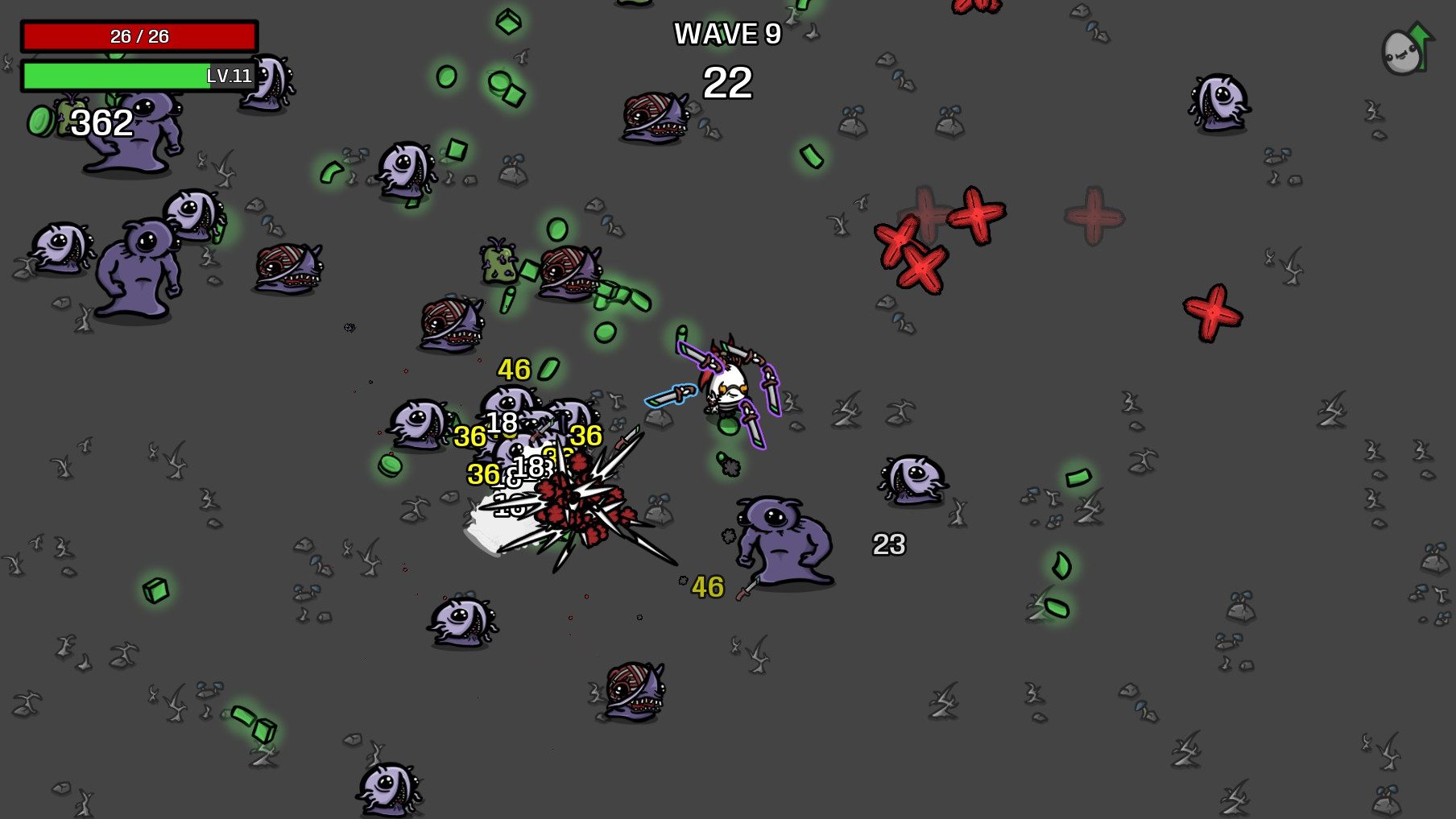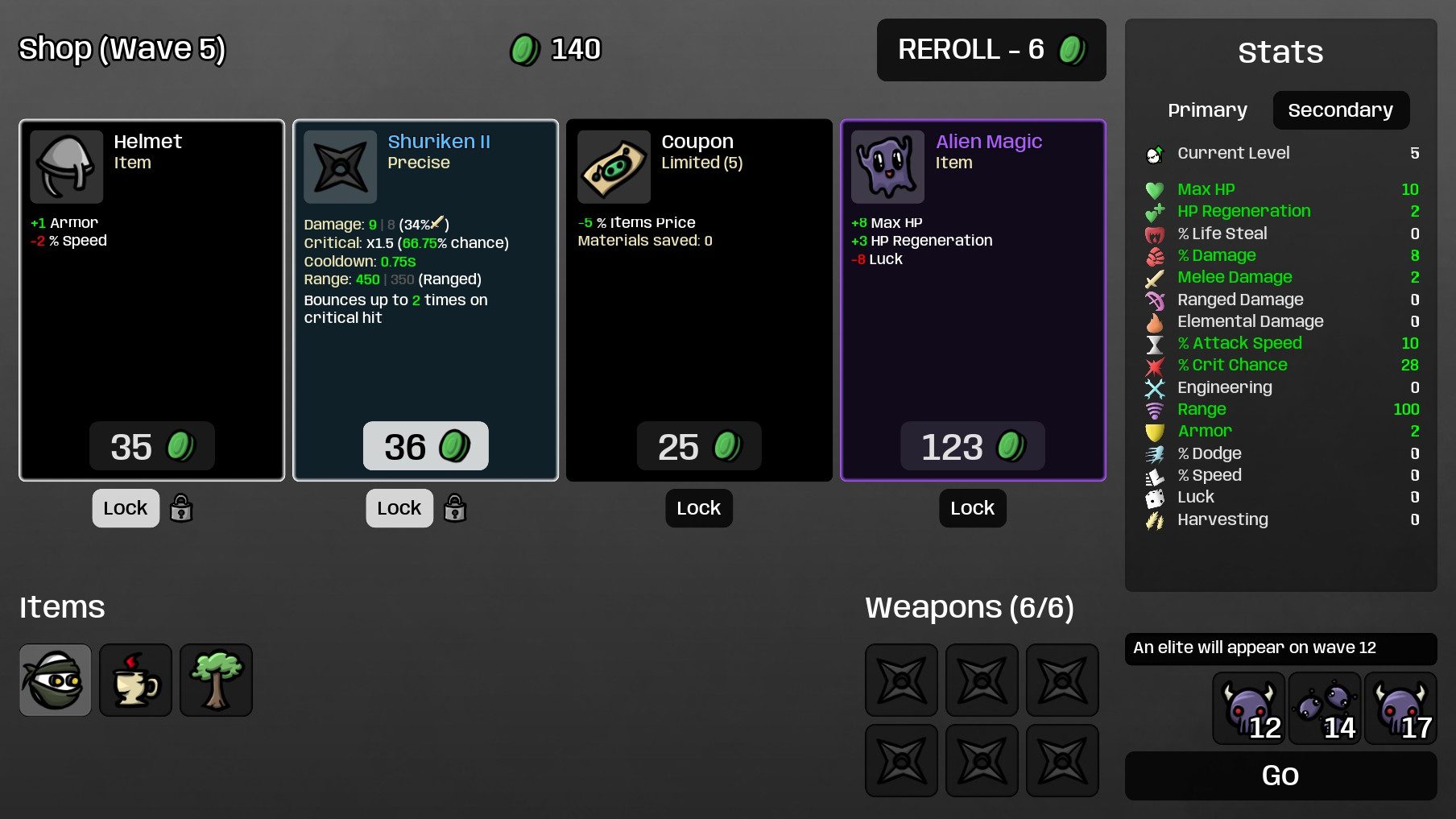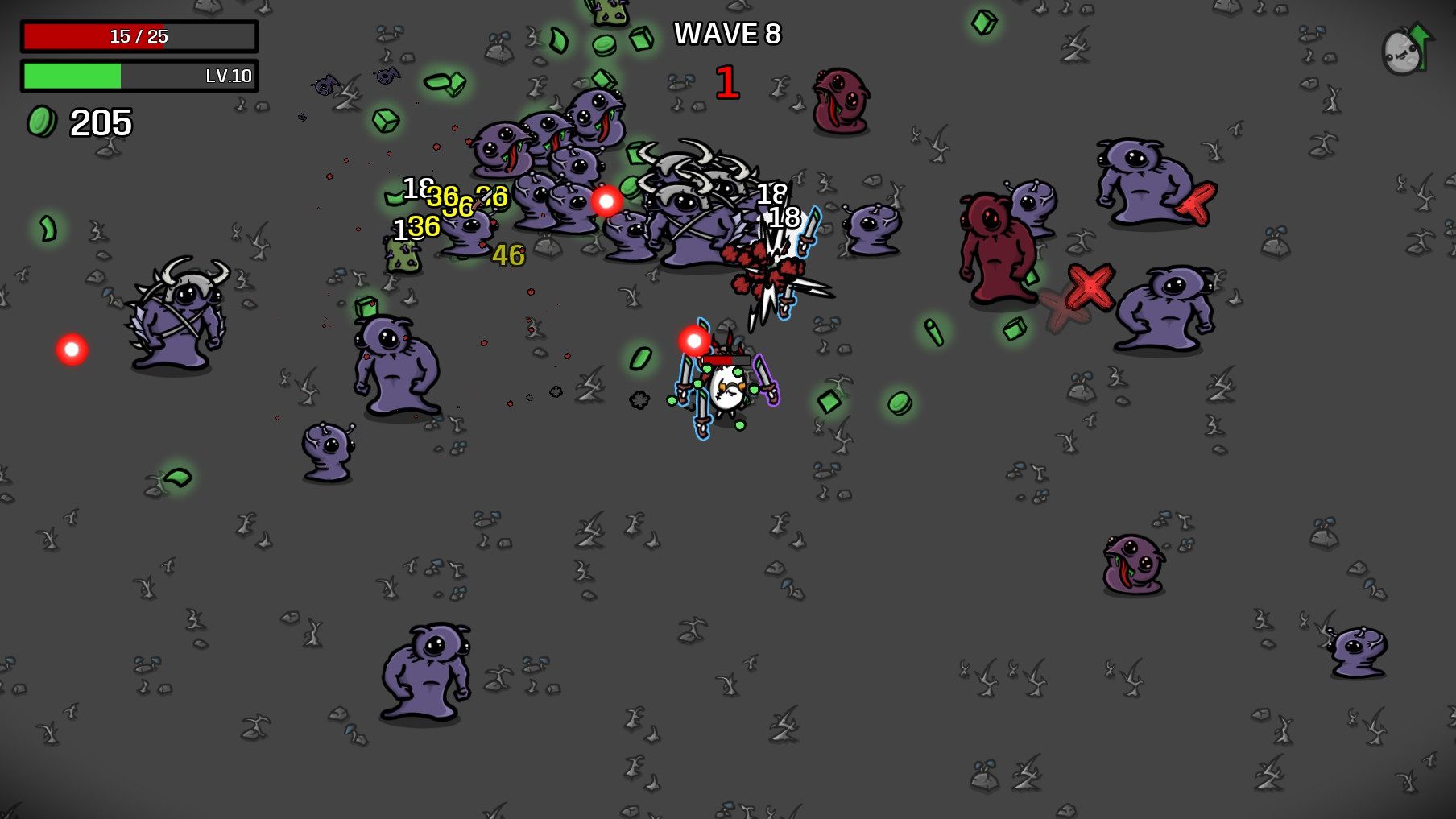One alien planet.
Hordes of hostile aliens roam the surface, ready to attack any intruder, hostile or benign.
A solitary sapient potato crash-lands on the planet, and while waiting for help to come, is determined to fight and survive. In the silence comes a heart-pumping electronic track with a syncopated beat and epic synth. He readies his weapon.

This is the premise–and the promise–of Brotato, Blobfish’s “bullet-heaven” rogue-lite shooter. In case anyone’s unaware of what that means, let’s take a brief second to explain:
This is a sort of sub-trend of the rogue-lite or “action roguelike”, begun by the explosively popular Vampire Survivors, and concerns arena shooters with three distinct features:
1. A horde of enemies is out to get the player, and the challenge usually consists primarily in surviving a set amount of time or waves.
2. Inventory management/upgrade subgames, which also function as a sort of “strategic layer” of stat management.
3. Very simple controls–most games in this space require only directional keys when you’re in the level.
Brotato is a newer project in this new design space and still in early access, but it’s already doing a lot of things right. The creator responds well to changes needed in its ‘meta’ and is constantly adding content and putting interesting ideas and twists into the game.
(“Rogue-lite” descriptor aside, it’s worth noting that the wave/level structure of the game involves very little in the way of procedural generation, at least as a noticeable driving force to the makeup of enemy waves.)
In any case, what is Brotato doing so well? It’s the combination of “one-more-run” gameplay and systemic exploration.

The one-more-run gameplay is pretty simple: You have to survive on the alien surface for about 20-30 minutes of real-time play, not counting time spent in shops and upgrade menus. In a given wave, you dodge and fight enemies, who drop materials that give both experience and currency. In-between waves, you can level up, receive items you’ve found in loot-boxes during the last wave, and visit a shop where you can spend money for more items as well as weapons.
You start with one weapon, and your Brotato can usually hold up to six weapons at a time, along with any number of other items to boost his stats and help in his struggle. Of course, the action layer of the game remains central. If you are good enough at dodging bullets and enemies, no Dodge stat–a chance for a “free” dodge when you get hit–is even necessary. But if you’re bad enough, no Dodge stat will keep you alive forever. If this looks or sounds like the sort of game that might be easy: it isn’t. The relief of finally making it past the final wave 20 is sweet indeed. With just one character, this might already be compelling for a few runs, but what really helps Brotato’s value is a combination of four factors:
First, the weapon system requires careful management of your money and your weapon slots. You only have six by default, and two weapons of the same type and level (e.g. two Level II Sticks, or two Level I Laser Guns) can combine to make one of the next level. This presents some interesting low-level choices in arsenal makeup as well as choices between getting weapons and other items. Weapons with similar types even have cumulative effects on your stats–for example, having two or more “Precise” weapons at the same time will increase your baseline chance to score a “critical hit” for more damage.
Second, the items you get all do different things to your stats, and may even affect things like enemy spawn rates. A number of them come with trade-offs that introduce further decisions on top of “can I afford this item?”. For example, the “Helmet” item adds +1 Armor (which mitigates incoming damage) and -2% Speed (making your character slower, appropriately.) For a character with speed to spare, that might be an easy call, but if you’re having trouble dodging enemies and bullets as it is, it becomes markedly less obvious.
Third, the character classes change up the game’s formula in both big and small ways. Each class brings a new balance to the table, and while they might broadly fall into a few groups, each puts its own unique twist on things. The default “Well-Rounded” class receives a bonus to three attributes, including “Harvesting”, which generates income passively, making it a great starter class, even though it’s not the most interesting in the game.
Fourth, there are many unlockable classes, items, and weapons that are only available after you’ve done certain things in a given run, or survived a whole run of the game with a given class. Each class has its own unique item or weapon unlocked on survival, and completing certain achievements in a run will likewise often unlock a given class. For example, reaching the normal maximum of a 60% Dodge rate unlocks the “Ghost” class, which has a maximum 90% Dodge rate but suffers a severe armor penalty. Some classes even change things like map size, weapon slots, and in a few cases radically alter the shopping experience. Even the difficulty levels in the game are unlockable, each opening up only as you conquer the previous difficulty for the first time.
And this systemic complexity, for players already hooked on the basic gameplay loop, provides a further incentive to dive back in after a successful or failed run: “What if I tried focusing on this stat? Or how about this class?”

Having a number of classes and items that are gradually unlocked as you play the game in different ways and at higher difficulties helps slowly introduce the game’s statistics and systems in a way that is easy to grasp but not necessarily easy to master, lending depth to the game without giving beginning players more information than they can handle.
A special shout-out should be made to the soundtrack. It’s not an original soundtrack, but Blobfish chose the music well for this game: A mixture of electronic tracks ranging from high-octane to slightly more ambient, but all chosen to resemble each other and lend an amazing level of attitude to Brotato.
To be honest, I don’t have a lot of negative things to say on a game-design front, although there are a few rough edges. One, at least as of this review, there are some classes that seem definitively stronger and easier than others. Two, while considerable effort is made not to overwhelm new players, someone coming fresh to the “rogue-lite” arena-shooter genre, or less driven to ask the question “now, what does this number do?” may be initially overwhelmed by the large amount of statistics and systems there are, even if they have no trouble dodging enemies. There are a few nuances that may not be obvious–e.g., additional range on melee weapons will increase the time it takes them to attack and recover, and it’s not always clear which items will activate in which circumstances. And the graphics get the job done, but are not necessarily anything to write home about themselves. They do maintain a pretty unified aesthetic, though–something one might expect from an older ‘edgier’ Flash game on Newgrounds or Kongregate. It feels like a similar-but-different throwback to other recent releases like Nobody Saves the World or Among Us.

Overall: Yes, this is a silly game about a sapient potato-person fighting aliens. But it’s committed to being what it is, and the resulting level of pure awesome achieved–whether you win or lose–is evidence of that commitment. Regardless of its few balance and conveyance issues, it is a game unafraid, at bottom, to be a silly video game that nonetheless takes the player seriously.
Of note, Brotato is still in early access. I began playing the game in late October/early November of 2022, and as of the time of my writing this review, it is now on early access version 0.6.1.6, and I have presently finished at least one run of the game with each available character class, and finished the highest difficulty run with three of the available classes.
Note from the author: This review is written for the Desktop version. Fellow reviewer KAMaximilianK notes that on the mobile version of the game, sweeping weapons like the wrench currently experience an issue as of 12/15/23 or earlier wherein they sometimes sweep enemies the wrong direction.
Scoring: 90%
Graphics: 4 / 5
Controls: 5 / 5
Gameplay: 5 / 5
Replayability: 4 / 5
Morality/Parental Warnings
Language: Clean
Violence: The game features a lot of real-world and fantastical weapons, and you will normally kill a lot of aliens in the course of a single run. There is some blood and gore, but mostly by way of cartoony effects that fade fairly quickly. A few classes (“Arms Dealer”, “Soldier”, and “Masochist” in particular) may be seen as glorifying violence. A few of the items imply Brotato doing violence to himself in one way or another to improve a stat.
Other: There are a few eldritch items available for pickup, such as “Alien Magic” and “Ritual.” There is a semi-vampiric Life Steal stat that gives a chance to recover hit-points when hitting enemies, and the “Sick” and “Doctor” classes rely in whole or part on this stat for successful runs. The “Demon” class unlocked after beating the current highest difficulty level uses its max HP to purchase items, but is a cartoon devil more than anything.
Brotato header/thumbnail image courtesy of the Brotato press kit.